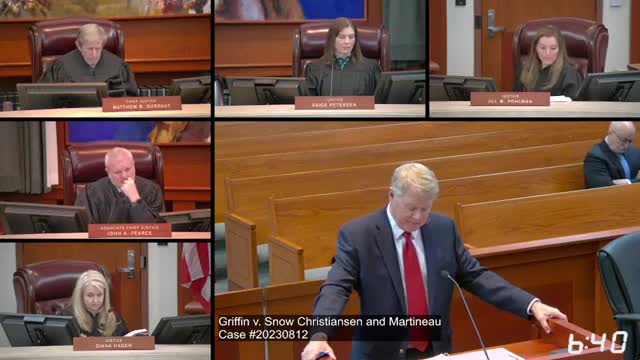Court of Appeals weighs role of Ms. Chapman in internal company matters
November 04, 2024 | Utah Supreme Court, Utah Judicial Branch, Utah
This article was created by AI summarizing key points discussed. AI makes mistakes, so for full details and context, please refer to the video of the full meeting. Please report any errors so we can fix them. Report an error »

In a pivotal session at the Utah Supreme Court, the case of Griffin v. Snow Christiansen and Martineau took center stage, drawing attention to the nuances of authority and responsibility within corporate structures. As the justices listened intently, the discussion highlighted the complexities surrounding the role of Ms. Chapman in her company, a focal point of the legal arguments presented.
The courtroom buzzed with anticipation as attorneys dissected the trial court's definition of authority. It was emphasized that Ms. Chapman did not hold a position of leadership or decision-making power within the organization. "She was not in charge. She didn't have authority," one attorney noted, underscoring the trial court's findings that were further elaborated in Judge Oliver's dissenting opinion. This dissent pointed out the clear delineation of Ms. Chapman's responsibilities, suggesting that her role did not equate to having the authority typically associated with corporate leadership.
However, the Court of Appeals took a different stance, acknowledging that while Ms. Chapman lacked formal authority, she played an "integrated role" within the company. This perspective raised questions about the implications of her position, suggesting that her involvement allowed her to influence the flow of information and decisions, even without direct authority. The justices appeared to grapple with this distinction, weighing the significance of Ms. Chapman's contributions against the backdrop of corporate governance.
As the arguments unfolded, the implications of this case extended beyond the individuals involved, touching on broader themes of accountability and the interpretation of roles within businesses. The outcome could set a precedent for how authority is defined and understood in corporate law, potentially reshaping the landscape for future cases.
With the courtroom's atmosphere charged with anticipation, the justices prepared to deliberate on the complexities of authority and responsibility, leaving observers eager to see how this case would influence corporate governance in Utah and beyond.
The courtroom buzzed with anticipation as attorneys dissected the trial court's definition of authority. It was emphasized that Ms. Chapman did not hold a position of leadership or decision-making power within the organization. "She was not in charge. She didn't have authority," one attorney noted, underscoring the trial court's findings that were further elaborated in Judge Oliver's dissenting opinion. This dissent pointed out the clear delineation of Ms. Chapman's responsibilities, suggesting that her role did not equate to having the authority typically associated with corporate leadership.
However, the Court of Appeals took a different stance, acknowledging that while Ms. Chapman lacked formal authority, she played an "integrated role" within the company. This perspective raised questions about the implications of her position, suggesting that her involvement allowed her to influence the flow of information and decisions, even without direct authority. The justices appeared to grapple with this distinction, weighing the significance of Ms. Chapman's contributions against the backdrop of corporate governance.
As the arguments unfolded, the implications of this case extended beyond the individuals involved, touching on broader themes of accountability and the interpretation of roles within businesses. The outcome could set a precedent for how authority is defined and understood in corporate law, potentially reshaping the landscape for future cases.
With the courtroom's atmosphere charged with anticipation, the justices prepared to deliberate on the complexities of authority and responsibility, leaving observers eager to see how this case would influence corporate governance in Utah and beyond.
View full meeting
This article is based on a recent meeting—watch the full video and explore the complete transcript for deeper insights into the discussion.
View full meeting

